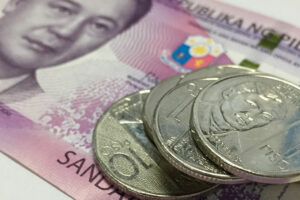




Philippines Trade Update: Trade trajectories trend along
 DOWNLOAD
DOWNLOAD

Policy Rate Updates: Double cut finale
 DOWNLOAD
DOWNLOAD

Monthly Economic Update: One for the road
 DOWNLOAD
DOWNLOAD


Peso may move sideways versus the dollar on BSP, Fed move bets

THE PESO is expected to trade sideways against the dollar this week amid bets on the next policy moves of the Bangko Sentral ng Pilipinas (BSP) and the US Federal Reserve.
The local currency closed at PHP 55.79 versus the dollar on Friday, down by four centavos from Thursday’s PHP 55.75 finish, data from the Bankers Association of the Philippines’ website showed.
Week on week, however, the peso weakened by 49 centavos from its PHP 55.30 finish on May 5.
The peso opened Friday’s session at PHP 55.86 versus the dollar. Its worst showing was at P56.02, while its intraday best was at PHP 55.65 versus the greenback.
Dollars traded rose to USD 1.488 billion on Friday from the PHP 1.29 billion seen on Thursday.
The peso declined against the dollar on Friday due to a possible pause in the Fed’s rate hike cycle after US weekly jobless claims jumped to a one-and-a-half-year high, Rizal Commercial Banking Corp. Chief Economist Michael L. Ricafort said in a Viber message.
The number of Americans filing new claims for unemployment benefits jumped to a one-and-a-half-year high last week, pointing to cracks in the labor market as demand slows, potentially giving the Fed room to halt further interest rate increases next month, Reuters reported.
With demand cooling, inflation pressures are subsiding. Producer prices rebounded modestly in April, leading to the smallest annual increase in wholesale inflation in more than two years, other data from the Labor department showed on Thursday. The reports were seen as consistent with most economists’ expectations of a recession by the end of the year.
Initial claims for state unemployment benefits increased 22,000 to a seasonally adjusted 264,000 for the week ended May 6, the highest reading since October 2021. Economists polled by Reuters had forecast 245,000 claims for the latest week.
The four-week moving average of claims, considered a better measure of labor market trends as it strips out week-to-week volatility, rose 6,000 to 245,250, the highest level since November 2021.
Economists say claims in a 270,000-300,000 range would signal a deterioration in the labor market. The week’s surge could mark the start of an upward trend as the cumulative and lagged effects of the Fed’s rate hikes broaden out in the economy. Layoffs, which were initially concentrated in the technology and housing sectors, appear to be spreading to other industries as companies gear for weak demand.
The US central bank raised borrowing costs by 25 basis points (bps) for a 10th straight time at its May 2-3 meeting, bringing the fed funds rate to 5% to 5.25%.
The Fed has hiked borrowing costs by 500 bps since March 2022.
Its next policy meeting is on June 13-14.
For this week, the peso is expected to move sideways as dollar weakness is expected to persist amid a possible pause in the Fed’s rate cycle, Union Bank of the Philippines, Inc. Chief Economist Ruben Carlo O. Asuncion said in a report.
“Broad dollar weakness may be expected in the FX (foreign exchange) space as the market has started to price in a Fed pause,” Mr. Asuncion said.
He added that the Bangko Sentral ng Pilipinas (BSP) is likewise expected to pause this week as inflation has shown sustained easing.
BSP Governor Felipe M. Medalla last month said the Monetary Board could consider holding rates steady at their May 18 meeting if inflation eased further in April.
The BSP has raised benchmark interest rates by 425 bps since May 2022 to help bring down elevated inflation, with its policy rate at a 16-year high of 6.25%.
Headline inflation eased to 6.6% in April, the slowest in eight months or since the 6.3% print in August 2022, data from the Philippine Statistics Authority showed.
For the first four months, inflation averaged at 7.9%, still above the BSP’s 2-4% target and 6% forecast for the year.
“Concerns of a persistent trade deficit overhang further compounded by solid growth numbers should keep the peso under pressure,” Mr. Asuncion added.
The country’s trade balance amounted to a USD 4.93-billion deficit in March, widening from the USD 3.91-billion shortfall recorded in February and the USD 4.59-billion deficit in March last year, preliminary data from the Philippine Statistics Authority showed.
Meanwhile, GDP growth slowed to 6.4% last quarter from 7.1% in October-December 2022.
This was also below the 8% expansion seen in the first quarter of 2022.
Still, this was faster than the 6.1% median estimate in a BusinessWorld poll of 23 analysts conducted last week.
The government targets 6-7% GDP growth for the year.
For this week, Mr. Asuncion expects the peso to trade between P55.30 and P56 per dollar, while Mr. Ricafort sees it moving from P55.70 to P55.90. — By A.M.C. Sy with Reuters
This article originally appeared on bworldonline.com





 By BusinessWorld
By BusinessWorld